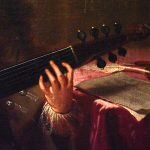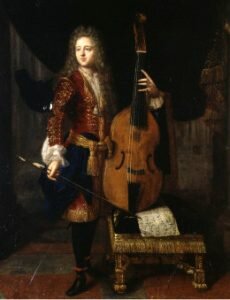“IN THE BEST OF HANDS”
Marin Marais & Johann Schenck
Two accomplished soloists speak elocuently through their instrument:
the viola da gamba

Programme
I
| Sonata in a-minor (L’Echos du Danube, Op. 9, 1704) Adagio – Giga – Corrente – Adagio – Vivace |
|
| — | |
| Johann Schenck (1660- ca. 1717) | Sonata in C-major (Tyd en konst-oeffeningen, Op. 2, 1688) |
| — | |
|
Sonata in G-major (Le Nymphe di Reno, Op. 8, 1702)
Allegro – Aria Allegro – Adagio – Ciacona |
|
| * * * * * * | |
|
Suite in d minor (Premier Livre des Pièces de Viole, 1686)
Prélude – Allemande – Courante – Sarabande – Gigue |
|
| — | |
| Marin Marais (1656-1728) | Suite in B-minor (IIme Livre, 1701) Prélude – Petite Fantaisie – Allemande – Sarabande – Gigue – Tombeau pour Mr Loulie |
| — | |
| Suite G-major, (Premier Livre, 1686) Prélude – Allemande – Courante – Sarabande – Gigue – Chaconne |
|
 |
 |
Marais |
Schenck |
“An incomparable French Violist da gamba, whose works are known in the whole of Europe”.
Thus described Johann G. Walther the extraordinarily gifted composer and performer, Marin Marais, who left us the most important body of music for the viola da gamba in France. Marais studied the viol for six months with Le Sieur de Sainte-Colombe, with certainty the most prominent teacher in Paris. He also studied composition with Jean-Baptiste Lully, who bestowed upon him the singular privilege of conducting the opera orchestra in his place. With 22 years of age he assumed the position of “Ordinaire de la Chambre du Roy”, the highest position possible in the absolutist France of Louis XIV, a position which he kept until three years before he died. The five volumes of Pièces de Viole which he published between 1686 and 1725, contain suites principally of dances for one, two or three viols with basso continuo, together with genre pièces of a descriptive nature. Poetical inspiration, finely cultured melody, clearly organised periodicity and, above all, bonne grâce characterise his style
In 1686 Marin Marais (1656-1728), then 30 years old, presented himself to the long expectant Parisian public through his revolutionary first book of Pièces à une et deux violes not as an emerging young talent, but rather as a mature, successful, prominent and recognised artist of the first category. By virtue of its imposing scale (the solo viol part alone fills around 150 pages!), of the meticulous care in the notation of the indications for performance (ornaments, bow strokes, fingerings, etc), of the luxuriously and aesthetically perfectly wrought copper plates executed by the Parisian engraver, M. Bonneüil, but, above all, by virtue of the profound expression of Marais’ personal musical language, whose ambitus reaches from high drama to the most sublime emotions, this magnificent volume reduced all other compositional efforts of his contemporaries to mere shadows. It set a standard which would never be equalled, nor seriously challenged in times to come. The graceful creations of Du Buisson, whom one cannot deny a prominent role in the development and forming of the French suite, lack the inner spirit, without which these works remain but delightful trivial diversions.
The formless attempts at composition which his conceited contemporary, Le Sieur De Machy, published in 1685, demonstrate regrettably little expressive content, notwithstanding the fact that his long preface indeed contains substantial information concerning performance practice of the times, particularly on the viol. Even the “concerts a deux violles” by his teacher, Sainte-Colombe, occasionally imbued with a pinch of poetry but more often revealing grave inadequacies in compositional construction, turn pale when juxtaposed to the exquisitely chiselled melody and the nobly flowing basses of his gifted pupil.
It is in the sublimely expressive art of the keyboard compositions of Louis Couperin – truly the quintessence of his epoch, in the highly cultivated theatrical diction of Molière and Racine as well as in the musical language – coined by that General Commissar of all Musick in France, Jean Baptiste Lully – of the “tragedie lyrique”, a form raised to the pinnacle of perfection of the Era, in which one may find the noble origins – the Pegasus Fountain – for the crystallisation of the poetical art of Marin Marais.
An almost exact contemporary of Marais, Johann Schenck, although of German extraction, was born in Amsterdam in 1660. In 1697 he was appointed as “Kammermusikus” at the Court of Johann Wilhelm II, Elector of the Palatine (Pfalz) in Düsseldorf, a post he held until at least 1712.